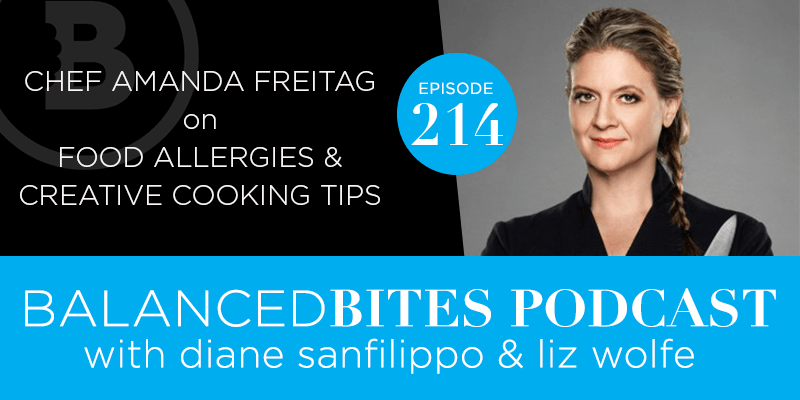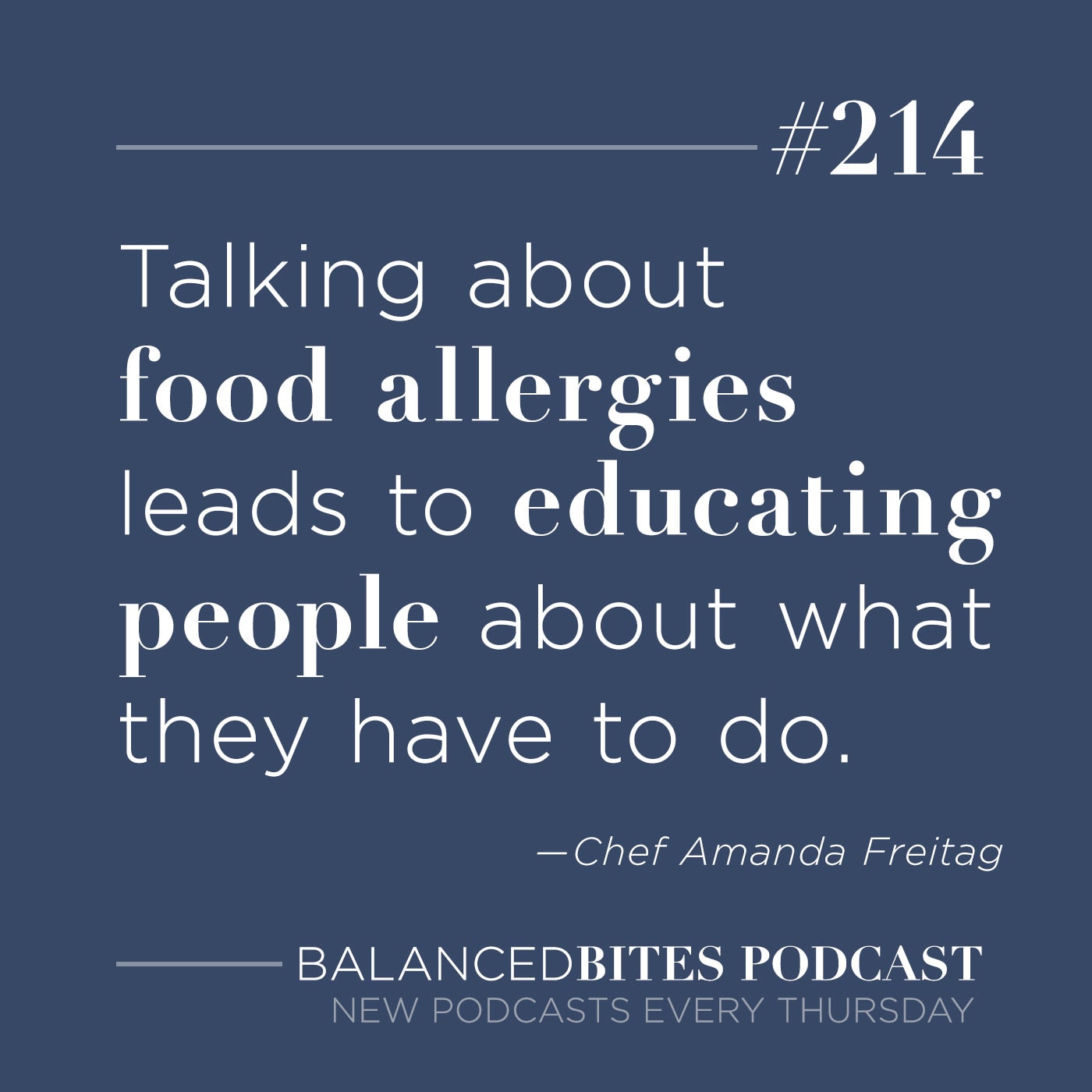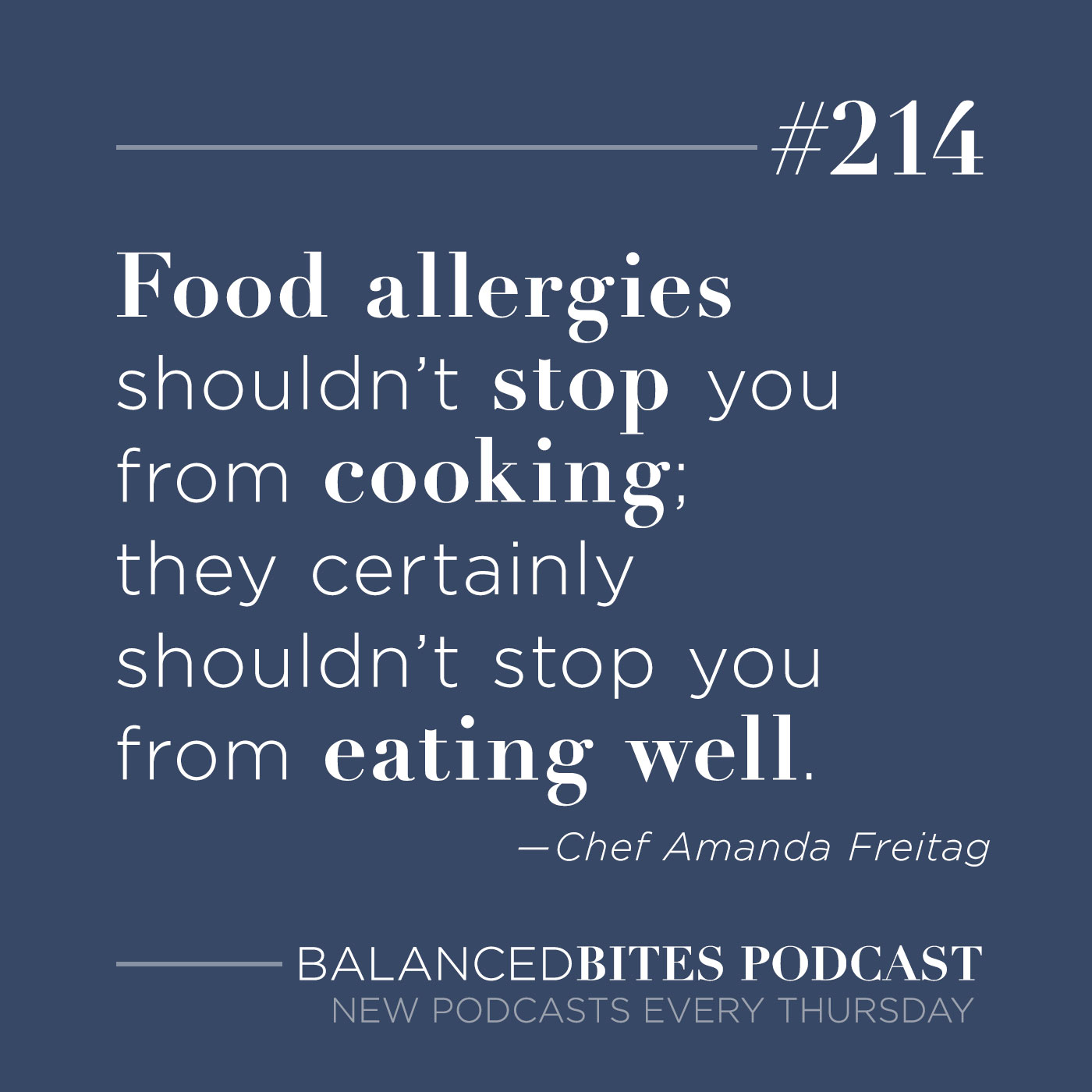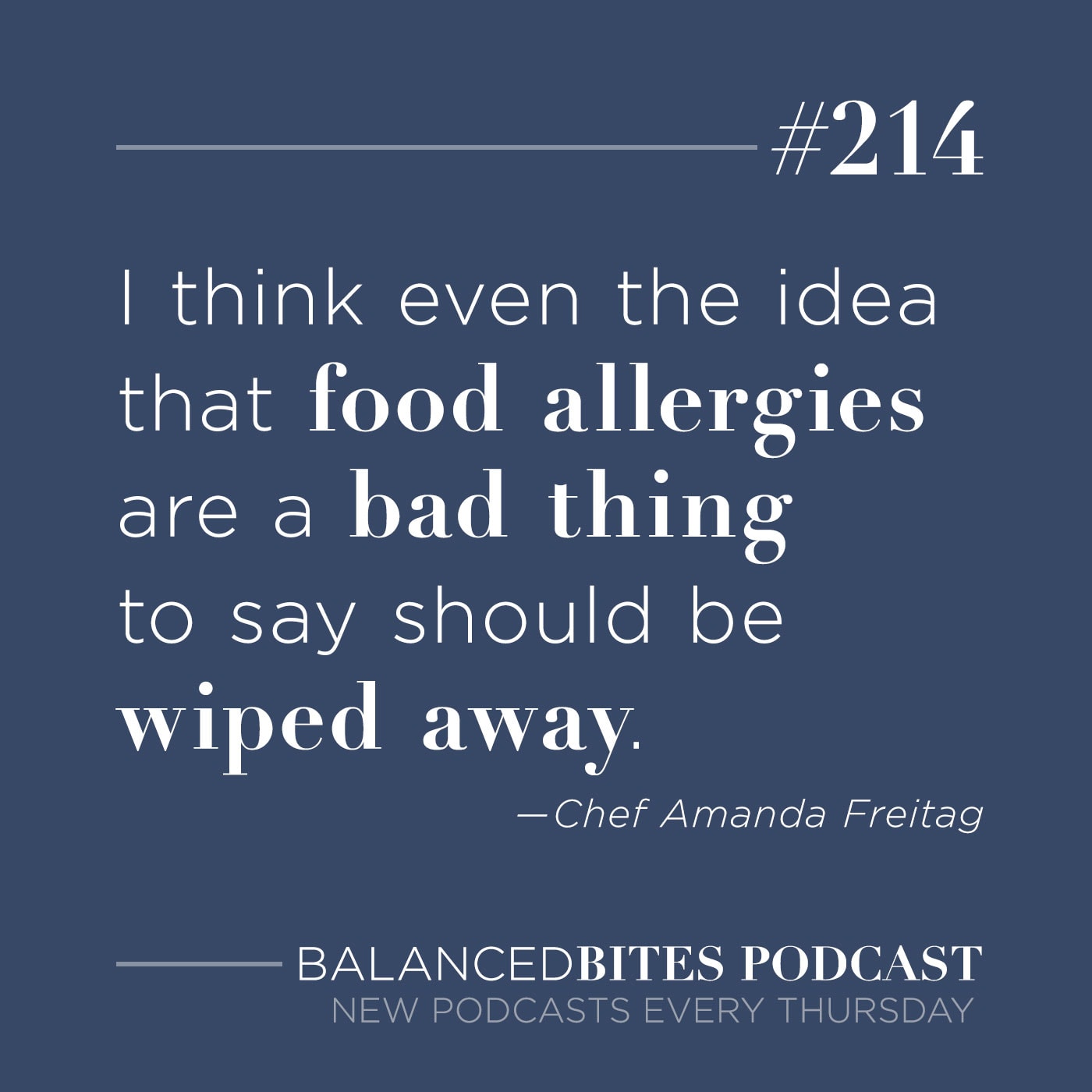Topics: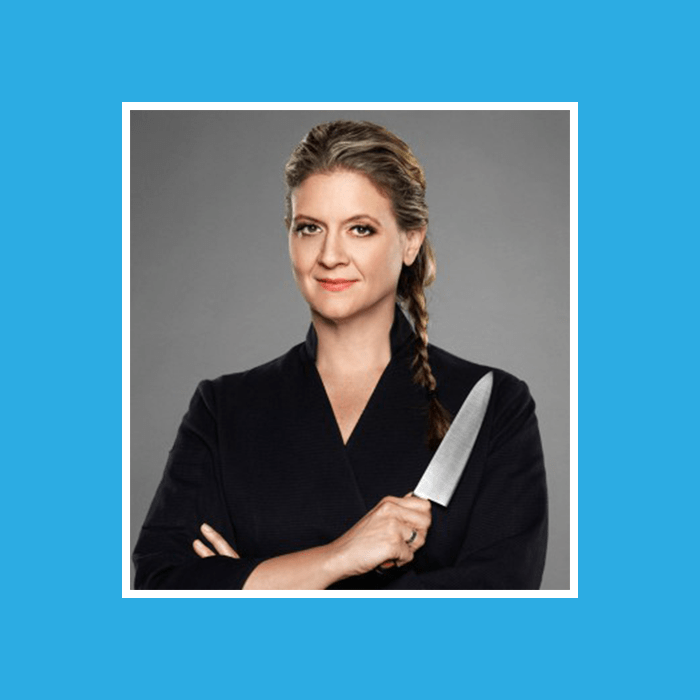
1. Updates from Diane [00:55]
2. Introducing our guest; Chef Amanda Freitag [4:07]
3. Emotional repercussions of allergy diagnosis [9:24]
4. Suggestions for EpiPen use [15:56]
5. Allergy awareness in restaurant kitchens [18:04]
6. Creative cooking tips from Chef Amanda Freitag [25:52]
7. Chef Amanda Freitag’s new cookbook; The Chef Next Door [28:20]
[smart_track_player url=”http://traffic.libsyn.com/balancedbites/21420final2.mp3″ title=”#214: Chef Amanda Freitag on food allergies and creative cooking tips” artist=”Diane Sanfilippo & Liz Wolfe ” color=”00AEEF” social=”true” social_twitter=”true” social_facebook=”true” social_gplus=”true” ]
![]()
Links:
Subscribe to DianeSanfilippo.com
The episodes are also available in iTunes & Stitcher.
![]()
Show sponsors:
 |
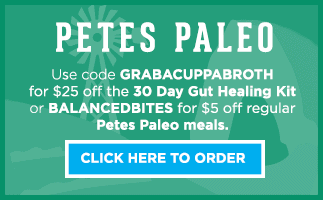 |
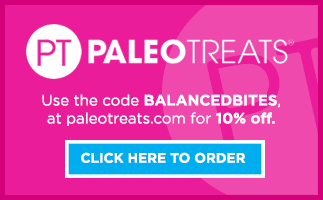 |
![]()
Balance Bites: Episode #214: Chef Amanda Freitag on food allergies and creative cooking tips
You’re listening to the Balanced Bites podcast episode 214.
Welcome to the Balanced Bites podcast with Diane Sanfilippo and Liz Wolfe. Diane is a certified nutrition consultant, and the New York Times bestselling author of Practical Paleo, The 21-Day Sugar Detox, and co-author of Mediterranean Paleo Cooking. Liz is a nutritional therapy practitioner, and the best-selling author of Eat the Yolks and The Purely Primal Skincare Guide. Together, Diane and Liz answer your questions, interview leading health and wellness experts, and share their take on modern paleo living with their friendly and balanced approach. Remember our disclaimer: The materials and content within this podcast are intended as general information only, and are not to be considered a substitute for professional medical advice, diagnosis, or treatment.
1. Updates from Diane [00:55]
Diane Sanfilippo: hey everyone! Welcome back to the Balanced Bites podcast. Diane here today, and I’ve got a very special guest, but before I get into my interview with Chef Amanda Freitag, I wanted to mention a couple of quick updates to you guys. The 21-Day Sugar Detox Coaches program has officially closed, so if that was something you were interested in, please stay tuned on the Facebook group for the 21-Day Sugar Detox coaches. It’s an interest group, so just go ahead and search that, hop in there, and you’ll find out when enrollment opens up again in 2016. We don’t have exact dates yet, but we will definitely keep you posted.
You guys here on the podcast will definitely know, and if it’s something that you’re interested in, you do need to make sure that you complete a 21-Day Sugar Detox before you hop into the coaches program. It’s absolutely something that I want to everyone make sure that if you want to become a coach, that you get your chance to go ahead and go through the program first, because I just don’t think it makes sense to coach people on a program that you have not done yet.
So on that note, the next big group we have kicking off for the 21-Day Sugar Detox is Monday, November 2, and we have 3 weeks there. You will end up right before Thanksgiving, a few days before Thanksgiving, so you can head into your holiday without worrying that you are just on the detox. And we also kick off a group, as well, in December; however that one will kicked off December 7th, so that would go through Christmas. So if you’re looking to get your detox done before the holidays, definitely November is a great time.
And keep in mind that I also do have Practical Paleo Holiday, which is available over on Amazon as a kindle book for just $2.99. So if you do want some healthy, paleo friendly holiday recipes, I think I’ve got over 40 recipes in there, and $2.99 is the cheapest Amazon would let me make it because it’s such a big file. But you can definitely check that out over on Amazon for kindle. And if you don’t have a kindle, you can use it on any kind of iPod, iPad, any kind of device using the kindle app, which is free. So anybody can access it, and you can make some healthy holiday recipes for your whole family. Let’s hear from our sponsors before I get into my interview with Chef Amanda Freitag.
Diane Sanfilippo: Pete’s Paleo is a friend of the Balanced Bites podcast. They’re bacon is insanely delicious, and sugar free, and their premade paleo meals make your life so much easier when everything is getting busy and getting real food on the table is still a top priority, as it should be. Pete’s Paleo is now offering a 30-day gut healing kit containing bone broth, gelatin gummies, instant organic soup packs, and an E-cookbook. It’s the perfect complement to any anti-inflammatory diet. Get yours today at guthealingkit.com. Use code GRABACUPPABROTH to get $25 off; that’s an amazing deal. It’s GRABACUPPABROTH, C-U-P-P-A. And you can grab that code any time at BalancedBites.com to just read and make sure you’re typing it in right. You can also use code BALANCEDBITES to get $5 off any of their regular meal plans. Check out PetesPaleo.com today. Pete’s Paleo; bringing fine dining to your cave.
2. Introducing our guest; Chef Amanda Freitag [4:07]
Diane Sanfilippo: For Chef Amanda Freitag, life is like a box of mystery ingredients in a cooking competition. You have to be prepared for anything. This is particularly true for Amanda, as she manages her food allergy. Amanda was diagnosed with a food allergy to hazelnuts in 2011, after years of experiencing symptoms like an itchy throat and stomach pains. At first she didn’t want to let people know about her food allergy, as food is central to her personal and professional life. She was worried about not having the freedom to eat anything that came across her plate; but the more she started talking about it, the more she realized she wasn’t alone, and other’s she knew were facing the same challenges; even chefs.
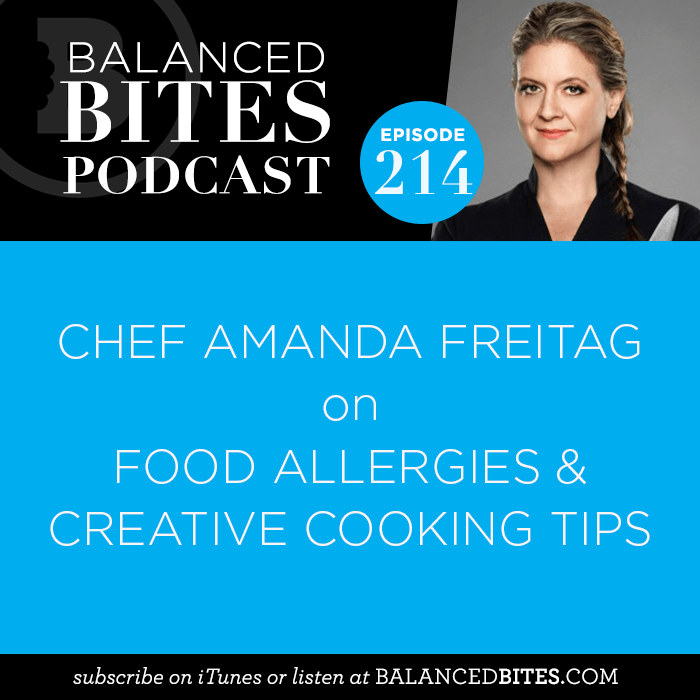
Whether she is working in the kitchen of her New York City restaurant, Empire Diner, or testing contestants creations as a cooking show judge, Amanda often handles unique ingredients and new recipes. So no matter the time or location, she’s always vigilant about avoiding her allergen and helping accommodate those dining with food allergies. Amanda knows that life happens, so you need to be prepared. She has an anaphylaxis action plan, which includes avoiding her allergic trigger, knowing the signs and symptoms of anaphylaxis, having access to two EpiPen autoinjectors, and seeking emergency medical care should anaphylaxis occur. Amanda makes sure to keep her two EpiPen autoinjectors in her home, in her restaurant, and on set, and always carries them with her wherever she goes.
Food allergies, a common cause of anaphylaxis, are on the rise; that’s why Amanda has joined Mylan to help educate others by sharing her personal experience of managing her food allergy while pursuing her passion as a chef and restaurateur. Visit EpiPen on location to learn more about Amanda’s story, and help spread the word about the EpiPen on Location initiative. Amanda Freitag is a paid spokesperson of Mylan.
Alright, welcome to our guest Amanda Freitag; thanks for joining us today.
Amanda Freitag: Thanks for having me!
Diane Sanfilippo: Awesome. I’m really excited to chat with you. I think probably a bunch of our listeners are familiar with you from some different TV shows they may have seen you on, knowing that you’re a chef who kind of has a higher profile. I’m just curious if you can tell people about your story with food allergies, because I know that’s what we’re really excited to talk to you about today. A little bit about your story, and the discovery of that being the issue that you had, as well as how it motivated you to create a platform around it.
Amanda Freitag: Yes. It was something that was obviously alarming, and I was first diagnosed with a potentially life threatening severe allergy to hazelnuts about 6 years ago. I started noticing that I was having some allergic symptoms, like itchy mouth, rash, upset stomach after eating, so I decided to see an allergist to see what was going on, because I ate so many different things in a day, I taste a lot of different things as a chef. So my allergist performed a series of tests, and diagnosed me with a potentially life threatening allergy to hazelnuts.
At first I was really nervous about telling other people about my allergy, because food is a huge part of my personal and professional life, and I was worried about not being able to have the freedom to eat anything I wanted. So it was really difficult for me at first, but the more I started talking about it, the more I realized how common food allergies are. I experienced it as a restaurant chef where other people who come into the restaurant have allergies; but amongst other chefs talking about it, and finding out that even other chefs had food allergies.
It’s a big part of my life; food is an essential part of my life, and living with a potentially life threatening allergy, it’s important that I take extra steps, so I’m prepared if anything should happen, a life threatening allergic reaction or anaphylaxis that I have to avoid my allergic triggers, obviously. It’s a lot of education, it’s a lot of being prepared and having access to epinephrine and having access to EpiPen and having it with me wherever I am; at home, at the restaurant, on set. That’s really important.
Diane Sanfilippo: Awesome. A huge percentage of our listeners have food allergies; a lot of them probably even more of them have food intolerances, which can be a lot of discomfort if not life threatening, it can still be pretty derailing to their entire day or week if they’re exposed to a certain food. So I’m curious what you’re experience is like. I can imagine first having this reaction; I actually have a similar allergy to most nuts; so hazelnuts. When I first {laughs} ate hazelnuts, and had the itchy mouth thing, I was like noooo! {laughs}
Amanda Freitag: Oh, I know, right? It’s such a bummer.
Diane Sanfilippo: Ugh. Because they’re so good. I could give up cashews easily.
Amanda Freitag: {laughs}
3. Emotional repercussions of allergy diagnosis [9:24]
Diane Sanfilippo: Yeah, hazelnuts, walnuts, pecans, almonds. I can’t eat any of those. But I haven’t gotten to the point where I have the same intense reaction, but it is that oral allergy that I know can develop further if I kind of abuse the foods that I’m having that reaction to. But I’m curious from just a little bit of the emotional side; I know this is a little touchy feely, but our listeners are experiencing a ton of this, and with multiple foods. So they know what it’s like; even though they’re not all working in the food industry, even just trying to hang out socially with other people; especially gluten is one of the biggest ones that our listeners deal with. How did that feel for you? I know you’re saying food is obviously an integral part of your personal and professional life; but just emotionally, was it kind of a beat down or did you feel like, wow there’s something wrong with me? Or my colleagues are going to think I’m crazy? {laughs}
Amanda Freitag: The good part is, one of the very first things that happened was I had to talk with the culinary producers on Chopped and let them know that hazelnuts could not be in any basket if I was judging; it could not be in the pantry, it could not be anywhere. So in talking to the culinary producers, and then talking to my other Chopped judges, I found out other judges had allergies, other people in the culinary team had allergies. So instantly I felt like; oh, ok. I’m not alone here, and it was no big deal to them. It was like; oh yeah, no problem, we’ll take hazelnuts out.
So in our industry, it’s really prevalent. So I was a little concerned; because as chefs we go to other chefs restaurants all the time, and they like to treat us. I like to treat chefs when they come to my place and make them something special. And so the hardest part as a chef is to sit down at a table and say, I have an allergy, I can’t eat these things. But at the same time, knowing what it takes to run a restaurant, you want your customer to say that. You want your diner to say that. You don’t want them to hold back on any information; the more information the better as far as I’m concerned.
I also grew up; my oldest brother has a gluten allergy; my niece has celiac. My mom is allergic to aspirin and penicillin; so we’re very aware of allergies just in growing up and what to look for. It wasn’t something that was a bad stigma; it was like, ok, we just have to be careful. There was a lot of awareness around if you have a hive, or if you have a rash, that means you may be having an allergic reaction to something. It was ok; you didn’t have to panic or you didn’t have to feel weird, you just took care of it. So luckily I grew up with that.
Yes it’s difficult to not be able to eat hazelnuts, not be able to offer them. But as soon as I started talking about it, and making people aware of what I needed, it became just fine. There was nothing wrong with it; nobody was bothered by it what so ever.
Diane Sanfilippo: That’s awesome. I do think; I had a similar experience. People ask me all the time about when I first; because most of our listeners eat pretty much like a paleo diet, so they avoid most grains and beans and processed foods in general, so they actually do eat a lot of nuts, unless they’re allergic, and trying to eat as many foods as possible outside of that, because they’re avoiding those things. And people ask me all the time if it was hard at first with my family; and I had a very similar experience to you. Not on the food allergy side, just kind of on the food choice side, where a lot of our family members were vegetarian for a long time, so our family was very used to; I eat this, I don’t eat that, and kind of just being sensitive to it so that’s great that you have that experience.
The cool thing is, the more people of high profile who have these issues who talk about them, it starts to make people feel less alone. Like exactly what your experience was. I think a lot of people don’t want to talk about it because they just don’t want to make a big deal of it. And I can appreciate that too; it’s like you don’t want to complain, or just be like, “woe is me.” But, I do think that having even somewhat of a platform around it, it makes other people feel like there’s nothing wrong with them.
Amanda Freitag: Right.
Diane Sanfilippo: Like they’re just like everyone else. So it helps.
Amanda Freitag: Yeah, that’s important. And I think talking about it leads to just educating people about what they have to do. And so that’s why, for me, it was a natural partnership with Mylan for me to be a spokesperson for EpiPen on Location initiative. And that’s just all about, where is your EpiPen, where do you have it? It’s all about preparedness. And that was really important to me to do that, even though I never experienced anaphylaxis, I know that you have to have plan. You have to be ready. And anybody who has a food allergy knows, the very first thing obviously is to avoid whatever it is you’re allergic to; and then, like I was saying, like my mom taught me growing up, recognize the symptoms of an allergic reaction and anaphylaxis.
Even for me; any kind of tingly mouth or itchy tongue or anything to me that is a big sign. And then having access to two EpiPen autoinjectors. I don’t just have one; I have two, always. And then, of course, if it got so bad, you’d seek immediate emergency medical care. But honestly, if you are smart and you are prepared, hopefully you never get to that point.
Liz Wolfe: We are thrilled to have Paleo Treats back on our sponsor roster. We love their treats, from the Mustang bar to the Bandito and everything in between. They have been serving the paleo community since 2009, and were recently recognized by FedEx as one of the top 10 small businesses in America. Which of course, speaks to how much paleo and healthy eating is growing, but it also speaks to how passionate our friends Nick and Lee and the Paleo Treats team are about what they do. Use the code BALANCEDBITES one word, no space at http://www.paleotreats.com/ for 10% off.
4. Suggestions for EpiPen use [15:56]
Diane Sanfilippo: Do most restaurants now, who have a heightened awareness about food allergies, are you somebody who would like to see that a restaurant might have something like an EpiPen around, or is this just a very personal responsibility? Because I actually grew up with a bee allergy, and I did have an EpiPen with me all the time when I was playing sports; there would be one in the medical kit from my soccer team or my volleyball team, etc. Mostly soccer, since that was outside. But in recent years, I have just never had one with me, and it’s a good reminder when we have this conversation.
Amanda Freitag: Yes. {laughs}
Diane Sanfilippo: Living here now where I’m outside a lot more often, it is something to be aware of. But it is good to hear you say that the itchy mouth is a very strong first indication; more often now when I feel it, I’m not trying to eat those foods, but if a chocolate bar was made in a facility and somehow it was on the line, like right after something with almonds or walnuts; I’ll just eat a plain chocolate bar and I’ll get that itchy mouth. And I’m like; well, can’t eat this one. {laughs}
Amanda Freitag: Right. There is trial and error. And the best thing you can do is just talk to your doctor. Honestly, that’s what helped me the most. They’ll tell you what’s right for you. They may not tell you what you want to hear, exactly, but they’ll tell you what's right for you, and then you have a plan. And make sure they’re aware of other medicines you’re taking, too. It doesn’t just have to be food allergies; there are many different allergies.
And also; the EpiPen, the doctor will show you how to use it, how to administer it into you're outer thigh. I think that’s also maybe something that people get scared of, but your doctor will show you how to do it. So honestly, it’s something that you should go and talk to your doctor about; really. As a chef, too, I just wanted to manage it on my own, but I had to work with my doctor to figure it out.
Diane Sanfilippo: Ok. I’m going to have to get a doctor. {laughs}
Amanda Freitag: {laughs} I sound like your mom right now, right? {laughs}
5. Allergy awareness in restaurant kitchens [18:04]
Diane Sanfilippo: Totally. Ok, so I wanted to talk a little bit about awareness in the kitchen, and kind of what happens in the kitchen around food allergies. I’m going to make a huge assumption that obviously in the kitchen of your restaurant that your chefs are very aware and very careful about what they’re doing; but I’m curious, what are some of the things that happen in the kitchen when someone says I have the following food allergy; and then what do you think that is like in other restaurants and how that compares across the industry.
Amanda Freitag: I can tell you what happens in our kitchen; other chefs I know do the same. When you get the notes that a diner may have an allergy; first and foremost I talk to the waiter and I say; ok, is it just one allergy? Are there other allergies? We really dig into what is going on with that person, because we want to make sure that there’s nothing in a stock or a sauce or a soup that is built into layering of flavors that maybe they would also have a reaction to. And then immediately, if that item is anywhere near other foods while that’s being prepared, that’s any allergen, I guess you would call it, would be removed.
So if you’re making a salad and there were pistachios in the bowl, that bowl gets put in the dish area, a new bowl happens, pistachios get taken away, gloves, you know. Every ingredient is new. So it’s a big deal to me because I know what can happen, and for a chef, we’re in the hospitality industry, we want to make people happy, we want to make memories. We don’t want to make people sick. So it may be a little extra time to make that dish; it may slow things down in the kitchen, but it has to be done.
And you know; it’s very important to educate the serving staff, as well as how to deal with that. If you don’t know if that thing is in the dish or not, go ask the kitchen. If somebody says; I have a peanut allergy, and the waiter doesn’t think there are peanuts, and they answer the question themselves, that could be a problem if it’s in the dish. So it’s very important that the staff is trained well; not only the cooks but also the front of the house; the waiters.
Diane Sanfilippo: So how would you recommend that a diner; and I think a lot of our listeners, again, they probably have a good amount of experience with this because they’ve known about allergies or intolerances of their own for a long time, but I’m sure we also have a lot of new listeners who, for them this is stuff that they’re just discovering, and they don’t really know how to navigate yet and how to ask the right questions or let their waiter or waitress know about their allergy; what do you recommend as sort of the best, I guess most gracious way to do it without {laughs}
Amanda Freitag: {laughs}
Diane Sanfilippo: Without skipping something that’s important, you know what I mean?
Amanda Freitag: I think even the idea that it’s a bad thing to say should be wiped away. You know? It’s just like ordering your meal. It’s the same thing. You’re saying; I want to steak, or you’re saying; I have an allergy. It’s exactly the same. And if it’s a place where you make a reservation, at that moment I think it’s really important to put it on the reservation, as well. Because restaurants want more info about you. Say they use a system where you make a reservation, it has you in their database and it has notes about you. So every time you come in, then, they’ll say, ok we know you have an allergy; has anything changed. Or, we’re aware of your allergy. The restaurants want to be hospitable. They want to help. So when somebody has an allergy, it gets written down in a note, or it goes straight to the chef. Reservation is great to have a note on there, and I think even telling the host/hostess. You always have to tell the waiter, and if you feel like that’s not enough, then you can talk to the chef.
I think it’s better to be comfortable, to be relaxed, to feel good. I take a lot of pride in knowing that somebody can come back and back again, knowing that I’m going to be careful about what they’re eating. That’s what great. If you have somebody who comes in with a food allergy, they have a great time, they feel safe, they feel comfortable, and then they come back, and then you say; oh yeah, hey! And it’s funny; you joke around with them. “Oh, you’re the mustard seed allergy. Ok, I got you.” You know? {Laughs}
Diane Sanfilippo: {laughs}
Amanda Freitag: It’s like somebody ordering a drink at a bar. It’s like, oh yeah, you have the old fashion; I remember you. It’s the same kind of thing.
Diane Sanfilippo: That’s awesome to hear. I think a lot of our listeners will feel a little bit relieved about it. And I do think that part of this; too, when we choose where we dine out, I think that; I don’t know. This might be strange to say, but it is something where, if you invest a little bit more in your dining out experience, and you’re going to a slightly nicer restaurant, I just think that the experience that you have in terms of how much the food is prepared to order and how careful they can be about what they’re doing tends to be improved over something that’s like a mass chain restaurant where something may be prepared more in bulk, even though food is being cooked to order.
So I think there’s a lot more that can happen specifically for a dish when you’re going out to a different type of restaurant. And I like you're recommendation there about on your reservation. I know, for example, I’ll use Open Table a lot.
Amanda Freitag: Yes.
Diane Sanfilippo: And I’ll just go in and type, we are both gluten free. I try not to say allergy because we don’t have the anaphylactic allergy, so I don’t want to say that if it’s not what I mean, but I do say we are gluten free, and I just like to let them know that ahead of time.
Amanda Freitag: Right. And that’s really important too, and I like that you said that. Because the only time you’ll ever see a server has frustration is when the person can’t really describe the allergy. You know? And that’s when maybe it’s just somebody who doesn’t want to eat that thing. When they don’t have a real allergy. So that’s when I think a server might get frustrated, when someone’s like; oh I don’t want garlic in that, just because they don’t want garlic breath. It’s like; if you know you have an allergy, exactly how to explain, your server is going to know that you’re serious, and it’s going to be very clear. I think the problem lies when it’s wishy washy. So if you are clear, and you say; you know what, it may not be a gluten allergy, but it’s a sensitivity, can you please accommodate us. At least you're being very clear about what you want. That’s important.
Liz Wolfe: Our podcast sponsorship today comes from Vital Choice, an online purveyor of the world’s best wild seafood delivered right to your door; because juggling a busy life doesn’t mean you should have to forgo healthy meals. At vitalchoice.com, you’ll find wild Alaskan salmon, halibut, tuna, sable fish, and cod, as well as prawns, crab, and scallops. You’ll also find grass-fed organic Wagyu beef, free range heritage chicken, fresh frozen organic berries, and dark organic chocolates. Make a vital choice by eating the highest quality food you can. Vital Choice; come home to real food.
6. Creative cooking tips from Chef Amanda Freitag [25:52]
Diane Sanfilippo: I think that’s helpful for people to know. Ok, so how about some fun stuff? What are some creative recommendations you have for people? Obviously a hazelnut allergy, that’s a super specific ingredient.
Amanda Freitag: Right.
Diane Sanfilippo: But like I said, we have so many people who have celiac disease, who have general autoimmunity and lots of varied allergies and things like that. What are just some ways to approach cooking creatively that you think can help people have a little more fun when they are dealing with some of these allergies or intolerances?
Amanda Freitag: This is; I’m coming on the heels of my cookbook just coming out, and I talk about recipes so much as being a guideline, and not to get stuck inside of a recipe. If there’s nuts in that dessert, turn the page and make a different dessert. Don’t just say; I can’t have desserts because I can’t have nuts. You know; 9 times out of 10, chefs are sensitive to those things, and they have a diverse mix of recipes available in books or online, and make something; there’s so many different things that are gluten free, dairy free.
We are so lucky to have access to amazing food. Especially in San Francisco and New York and the big cities, it’s available, which is so great. And when you're shopping in these amazing markets, the labels have everything on them now, you can read really closely, and then you can experiment. As soon as you get those ingredients and you feel good about them, you can experiment, and make a twist on a traditional recipe. Take a recipe and eliminate one thing, and add something that you can have. It shouldn’t stop you from cooking; it certainly shouldn’t stop you from eating well.
My brother raised two girls with allergies, and they’re thriving, and they’re teenagers, and they eat so well and so good, and he could probably write a whole cookbook on gluten free {laughs} cakes and bread. He makes bread, pancakes, everything. Those are things that kids want to eat, and he had to do it. He wanted to do it. He wanted them to eat well and feel good, so he wasn’t just going to skip everything and just give them a carrot stick. {laughs} I think that’s the worst, then you feel really deprived, and you feel hungry, and you just feel left out.
7. Chef Amanda Freitag’s new cookbook; The Chef Next Door [28:20]
Diane Sanfilippo: Awesome. I’d love to hear a little bit more about your new cookbook; The Chef Next Door. What is the direction of it, and some of your favorite recipes, and what you want people to know about it?
Amanda Freitag: The idea of the book is that it’s a pro-chef admitting how hard it is to cook at home. Growing up in restaurant kitchens and cooking with a pile of pots and pans; having dishwashers, having a big walk in refrigerator with products; it’s easy, and cooking at home is not. {laughs} Small space, limited amount of utensils, having to wash and clean everything, and chop, and do all of it. So it’s kind of a love letter to the home cook, and me navigating my way through my home kitchen, which rarely gets used. Giving over some advice saying; ok, here’s a better way to do this. Act like a chef; why not just be chefy and prep everything. Cut everything before you start the recipe, or here’s a way to really make beautiful scallops at home. People always ask me; how do you do that?
So it’s a book that’s filled with recipes that are very simple, very basic. Some of them are personal stories; really what I want is that book to go in the kitchen with everybody, I want everybody to take notes on those pages, make twists on the recipes, and just bring that book into the kitchen and make it one of those books that has notes in it and gets passed down from generation to generation. Because I’ve even made the paper matte so that people could write on it.
There’s a lot of really great one-pot meals, great clean cooking in there because a lot of what I ended up making for myself at home was clean food. When I say clean, meaning a kale chickpea tomato stew, because if I go out, and I’m traveling and eating on the road, a lot of time I don’t have access to great food. So I would eat that for dinner. Or I’d have a hearty lentil soup, or potato kale soup. Those things are dinner to me, or a beautiful lunch. So there’s everything from lobster, to rice pudding, to roasted lemon chicken. {laughs} It’s really a diverse book, and it will get even the most timid chef cooking in their kitchen.
Diane Sanfilippo: Awesome. I love it. Anything else you want to let people know, just about dealing with food allergies or anything else about cooking any last tips, and where we can find more information about you? I mean, we watch you all the time.
Amanda Freitag: Oh thank you! Just grab that book, make a dish, and send me a picture of it. {laughs} That’s what I really want to see; I want to see people using the book and send me an Instagram, send me a Twitter, send me something on Facebook. I just think it’s so cool that I get to share all those recipes, and that people are going to take them, they’re going to make them, they’re going to make a twist on them, and to me that’s just emotional, because it’s very personal to me. I love that, and I want to be in the kitchen when they’re cooking {laughs} but I can’t .So I’m really excited about people enjoying the book.
We’re doing more Chopped filmings. I’m going on the road to film American Diner Revival, which is a great show I’m doing with Ty Pennington on Food Network.
Diane Sanfilippo: Awesome. I’m totally with you when people make recipes from my books, or when they bring a book to a singing, and they’re so embarrassed because it’s all splattered; I’m like, no, no.
Amanda Freitag: I love that! That’s the best!
Diane Sanfilippo: {laughs} Yeah, it’s totally the best. The pristine; when I see a pristine copy that I know what from like a first print run, because I can tell the difference. It’s a New York Times’ best seller; it doesn’t say that on the front yet. And I’m like; this is a first print run, and you have not been using this enough! {laughs}
Amanda Freitag: {laughing} I totally agree.
Diane Sanfilippo: So funny. Well thank you so much for joining me today.
Amanda Freitag: Thanks Diane; thank you for having me.
Diane Sanfilippo: Thank you so much for listening, that’s it for this week. You can find me, Diane, at http://dianesanfilippo.com; you can find Liz at http://realfoodliz.com/, and Chef Amanda Freitag at AmandaFreitag.com. Join our email lists for free goodies and updates you don’t find anywhere else on our websites or on the podcast. While you’re on the internet, leave us an iTunes review. We’ll see you next week.

